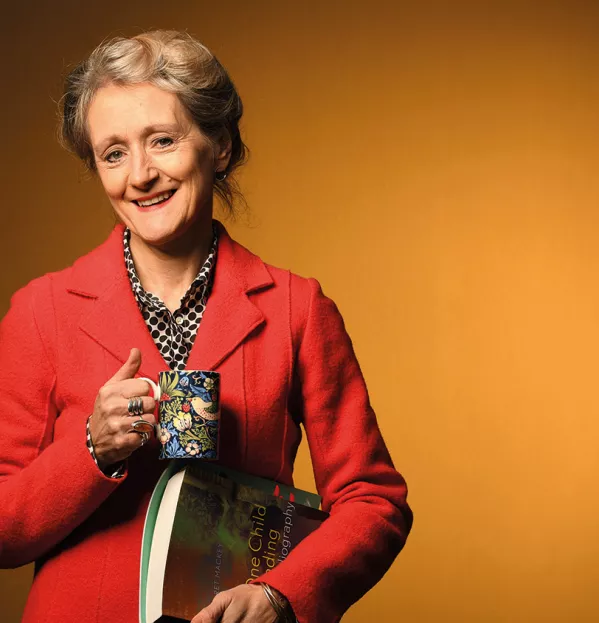Tes talks to...Teresa Cremin

Teresa Cremin has some questions for you: when was the last time you read a book? When was the last time you did some non-work-related writing? And when was the last time that you asked your students to do either of those things?
The answer to that last question will likely come more readily to mind than the answers to the first two. And Cremin, who is a professor of education at The Open University, thinks that is a problem.
“It’s critical to think about authenticity,” she explains. “It’s not about being a role model for the sake of it, but offering young people an authentic example of an adult reader and writer in their daily lives. It’s about teachers taking the risk to write in front of children or bringing in their pile of reading from the weekend.”
Cremin believes this is not just about motivational impact, but also making you a better teacher.
“If we reflect on ourselves as readers and writers, what we choose to read and how we engage, we’ll see that our practice is really diverse,” she argues. “You start thinking about what counts as literacy and being literate in the classroom. It’s not a case of ‘do as I do’, of course … but recognising this diversity and then thinking about some of the consequences. ‘Is my definition of literacy within my classroom wide enough? Or is it too defined by government definitions?’”
Cremin’s thinking is informed not just by her academic role, but also by her other duties: a fellow of the Royal Society of Arts and a trustee of the UK Literacy Association. She also has a background in psychology and is a former primary school teacher.
So let’s take the concept of teachers as readers first. What exactly does she mean by that? Cremin believes that the self-questioning process prompted by reading for pleasure as a teacher can lead to a better understanding of how to get students reading for pleasure, too. This, she argues, is crucial not just to create life-long readers, but also for broad academic success.
“International evidence suggests reading for pleasure offers massive cognitive and emotional benefits, as well as better attainment in maths and literacy,” she explains. “In fact, if you read independently outside school, it makes a difference to your life chances. And when you think about it, this makes sense: if you read for fun you’re going to have a wider vocabulary and better general knowledge, but you’ll also be able to think empathetically and be mindful about where other people are coming from. These are critical 21st-century skills.”
Reading for pleasure assists you in helping children to develop these skills because it gives you insights you otherwise would not have, she says.
“[For example,] having been reflective, you might think about where you like to read and how you’re most comfortable,” Cremin suggests. “For me, that might be curled up on my bed or my sofa. I recognise my rights to read what and where I want, and to talk to my partner about what I’m reading. All of those practices build autonomy and community, and we need to foster these same ideas in the classroom.”
Reading for pleasure also reminds you that reading is a social experience, she adds. “Reading is individual, but it’s hugely social, too. Children need to talk about what they’re choosing to read, not just what they have to study. And for them to be able to do that you need to create a community of readers in your classroom. They need to be able to see their teacher sharing books, but also being moved by them or laughing at them, or they need to hear her ask, ‘Who wants to read this after me?’
‘Book blether’ and reading for pleasure
“You need the collective in your classroom, including the teacher and the teaching assistant, too. That way, we’re not checking on each other; we are genuinely, having read a book, wanting and needing to talk about it. I call it ‘book blether’ - that human need to talk about what we’ve read, and life in general. This is where peer recommendations of books can come in handy, too.”
Peer recommendations for reading for pleasure should, she states, come from the teacher, as well as other students. And she says that this can be where some teachers struggle.
“Teachers have a professional responsibility to have a rich, wide knowledge of literature, yet there is evidence that some teachers rely largely on the books they knew and loved in their own childhoods,” she explains. “And while Roald Dahl is great, there are so many other writers that children won’t be introduced to unless their teachers know them. We need CPD that allows teachers to widen their knowledge of texts and helps them share their understanding and passion for those texts with their classrooms.”
That’s not to say she wants teachers to create generic whole-school reading lists.
“Increasingly, we offer lists to parents - and while there can be a benefit here in knowing the names of a wider range of authors, there’s also a danger that it becomes a kind of canon of literature, rather than children choosing what and who they want to read,” Cremin explains. “Besides, lists like this very quickly become out of date and if you start when your child begins primary school, five years later there’s literally nothing contemporary on that list.
“Rather than an endless list of pre-set recommendations, a ‘reading teacher’ (a teacher who reads and a reader who teaches) will be able to offer two or three suggestions targeted at an individual child.”

Reading for pleasure, though, is just one half of the equation Cremin set out at the beginning of this article: arguably harder for teachers to tackle, she believes, is becoming a more regular writer. But she points to a project called Teachers as Writers - which she undertook in partnership with Arvon, the creative-writing organisation, and the University of Exeter and which involved 16 teachers spending a week working with professional writers and writing themselves - to explain how important it can be.
“They wrote, they shared, they engaged in workshops - and, as a result, they learned an enormous amount about the nature of the writing process that you just won’t know unless you’re regularly writing alongside your pupils,” she explains.
“For instance, in that week it was very clear that teachers went for a walk to find the next part of narrative, or thought about it overnight. The opportunities they took to incubate ideas and explore possibilities were very different from how we often offer writing at school, where it’s much more likely to be a linear process of plan, draft, write, edit, then it’s marked. And we need to be aware that this is very different from the world of real writers.”
She adds that another issue that becomes clear when teachers write themselves is that sharing writing can be difficult.
“Many teachers lacked confidence when sharing their writing, or were very critical of their own work. And we need to recognise that children may similarly lack confidence when writing,” she says. “It’s one thing to give your class instructions, but when you sit down to do it, you think, ‘Wow, this is hard!’ Are you giving your children enough opening time, discussing time, time to generate ideas?”
Being willing to take the leap and share your own writing with students can be transformational, Cremin argues.
“If you’re authentic, you might be modelling or writing alongside the children, and then sharing what you’ve done - you can talk about what you were trying to do, what you as the author were intending - and this takes the discussion back to what writing is really about,” she explains. “You might also have a blank spot if you’re modelling authentically (no planning your ‘modelled write’ the night before!), but this can also help the children to understand that getting stuck on a spelling, for instance, is human and normal. It shows them that you can still be a writer and get stuck on a word, rather than, ‘I’m rubbish at writing because I’m not good at spelling.’”
Obviously being both a reader and being a writer alongside being a teacher is not easy - teachers are extremely overworked already, so reading for pleasure or writing a piece of prose will be tough. But Cremin’s suggestions include in-lesson modelling, too, and she argues that what is required is simply a different mindset: “We need less focus on reading and writing and more on what it means to be a reader and a writer.”
Kate Townshend is a primary teacher and freelance writer. She tweets @_KateTownshend. Ways to develop as a Reading Teacher are explored on the reading for pleasure website based on Teresa’s research https://www.researchrichpedagogies.org/research/reading-for-pleasure
For more information on Professor Cremin’s work, see the following:
Cremin, T. Mottram, M. Collins, F. Powell, S. and Safford, K. (2014) Building Communities of Engaged Readers : Reading for Pleasure London: Routledge http://oro.open.ac.uk/42513/
Cremin, T. (2010) Poetry teachers : teacher who read and readers who teach poetry in Styles, M. Poetry and Childhood London Trentham http://oro.open.ac.uk/24225/
Cremin T. And Oliver, L. (2016) Teachers as writers : a systematic review Research papers in Education http://oro.open.ac.uk/46451/
Cremin, T. Myhill, D. Wilson, A. Eyres, I. Oliver, L, and Nash, T. (2018) Teachers as writers : Arvon project report http://www.teachersaswriters.org/general/teachers-writers-full-research-report/ … Teachers as writers : exec summary ( 2017) http://www.teachersaswriters.org/wp-content/uploads/2017/05/Arvon-Teachers-as-Writers.pdf
Cremin T. And Locke, T. (2017) Writer identity and the teaching and learning of writing London : Routledge http://oro.open.ac.uk/47049/
New EEF/RSA project The Craft of Writing @tcraftofwriting
You need a Tes subscription to read this article
Subscribe now to read this article and get other subscriber-only content:
- Unlimited access to all Tes magazine content
- Exclusive subscriber-only stories
- Award-winning email newsletters
Already a subscriber? Log in
You need a subscription to read this article
Subscribe now to read this article and get other subscriber-only content, including:
- Unlimited access to all Tes magazine content
- Exclusive subscriber-only stories
- Award-winning email newsletters